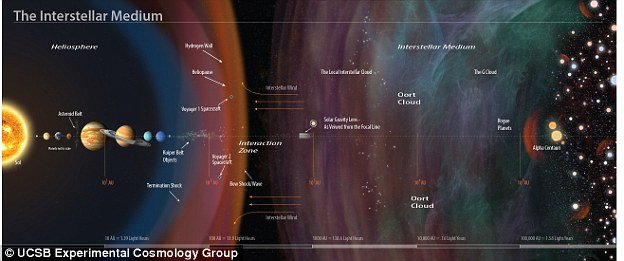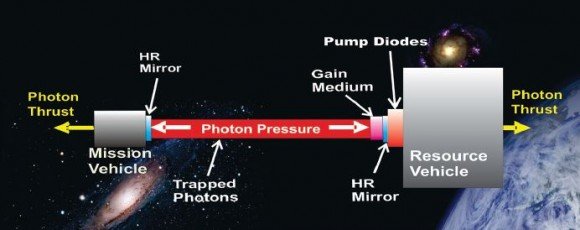Traveling to Mars in 3 Days? Photonic Propulsion - The Future of Space Travel

The Universe seems to be almost endlessly big, and humans are desperate to explore it!
Everybody is talking about colonizing Mars, and how we need to find another planet to live on.
Although our current space technology already seems pretty advanced, we are actually still very limited in our possibilities to explore other planets.
The Voyager 1 was sent off in 1977 - and it only just left our solar system!
It's obvious that we need to do something about the way we travel in space.
Currently, space ships are still using chemical acceleration - they're burning fuel, which is very heavy and expensive .
And not very fast.
But last year, Prof. Lubin from the UC Santa Barbara has received funds from NASA to improve a new technology that could possibly change space travel forever.
Project Deep In
The project is called DEEP IN and uses a technology called "Directed energy system for targeting of asteroids & exploration" (DE-STAR).
Unlike regular spaceships that are powered by fuel, Deep in is using the power of light to travel at a much higher speed.
With this technology, we could reach 1.5% of the speed of light - 300 times faster than the current Voyager one!
We would be able to reach mars in only 3 days -which is a distance of 225 million km and currently takes several months!
It could even be possible to reach Alpha Centauri, the closest star system to us, in a matter of 17 years.
"We will never reach even the nearest stars with our current propulsion technology in even 10 millennium. We have to radically rethink our strategy or give up our dreams of reaching the stars, or wait for technology that does not exist."-Prof. Lubin, UC Santa Barbara
How does it work?
The Deep In Project uses a technology called "Photonic Propulsion".
It uses electromagnetic acceleration to move the spaceship forward - not fuel!We might not notice it normally, but light actually has an immense power to push something forward.
The technology works similar to a solar sail: When the photons meet the surface, their momentum gets transferred and makes the spacecraft move.
But solar sails are limited in their ability, because natural sunlight only has so many photons.
So instead, photon propulsion uses gigantic lasers that emit a concentrated stream of photons to push the spaceship forward. This way, an incredible speed could be achieved, as well as making the craft itself much lighter because there's no need to store any fuel .
Challenges
Obviously, the technology is not fully developed yet.
There is still a long way to go until we could actually travel with photonic propulsion through space.
The first challenge would be to build the laser - it would have to be a square of 10x10 kilometers to be big enough to propel an aircraft.
So it would be incredibly difficult to carry all the supplies to space, let alone assemble them there.
Also, scientists don't know how they would slow down an air craft traveling with such incredible speed yet.
Nothing in space would slow it down naturally, so an initial push could keep the spaceship going - but they would have to find a solution to stop it when it's reached its destination!
For now, the researchers have agreed to start with a laser that's 1x1 meter, and then just scale it up as much as possible, trying to figure out how to solve these challenges on the way.

Personal Opinion
I'm amazed how fast the space industry is advancing! In my opinion, it was only a matter of time until they had to replace fuel as acceleration method with something else. Fuel is limited, heavy and expensive - and it slows the space ship down.
I know we are still very far from actually implementing Photonic Propulsion, but the fact that the theory itself works is already a huge step in the right direction.
Now it's only a matter of perfecting and scaling up the method, and I'm excited to see where this technology could possibly take us in the future!
Images: 1, 2, 3, Sources: 1, 2, 3
- Instagram -

© Sirwinchester

That's funny you made a post about this because I am doing a project on this exact subject in Science!
What a coincidence, maybe you can make use of some of my sources! It's definitely a fascinating topic
wow imagine this becoming a reality, it would revolutionize the way we live and give us opportunities that we can't even imagine right now
It would change the whole way we think about space!
But right now it's not more than a hypothetical plan ..
your math dont hold up.
At 1.5% of light speed you cant reach a star that is several light years away in 17 years. If I remmeber correctly, Alpha Centauri is 3.7 light years, means at 1,5% light speed it would take about 300 years.
Also the "fly to mars" model has a significant error:
How do you brake?
If you have a laser that powers you by "bombarding" then what is stopping you?
Also I guess the g forces to make it in 3 days would be too high - several g permamently. But someone else can do the math on that.
Exactly that's the problem! The scientists haven't found a solution for a brake yet, like mentioned above.. that would be a VERY big problem if they don't come up with something to solve it, there would be absolutely nothing to stop the aircraft from crushing into another planet at full speed!
But obviously, this whole project is still very much a theory, and I'm not sure about the detailed numbers.
All I know is that this is an exciting idea, but there is still a LOT of work today if we want to see this come to life!
Where do you get such great information everyday? You sure do know a lot of stuff.
Thank you, I appreciate that!
I just check the tech/science news everyday and share whatever I think is quite interesting :)
Good stuff. Thanks!
You're welcome, glad t hear that you enjoyed it!
Hey, I just noticed that you have your own "tag" - how does that help? Should/could I have one too?
Great article !
This post has been ranked within the top 10 most undervalued posts in the second half of Dec 11. We estimate that this post is undervalued by $35.39 as compared to a scenario in which every voter had an equal say.
See the full rankings and details in The Daily Tribune: Dec 11 - Part II. You can also read about some of our methodology, data analysis and technical details in our initial post.
If you are the author and would prefer not to receive these comments, simply reply "Stop" to this comment.